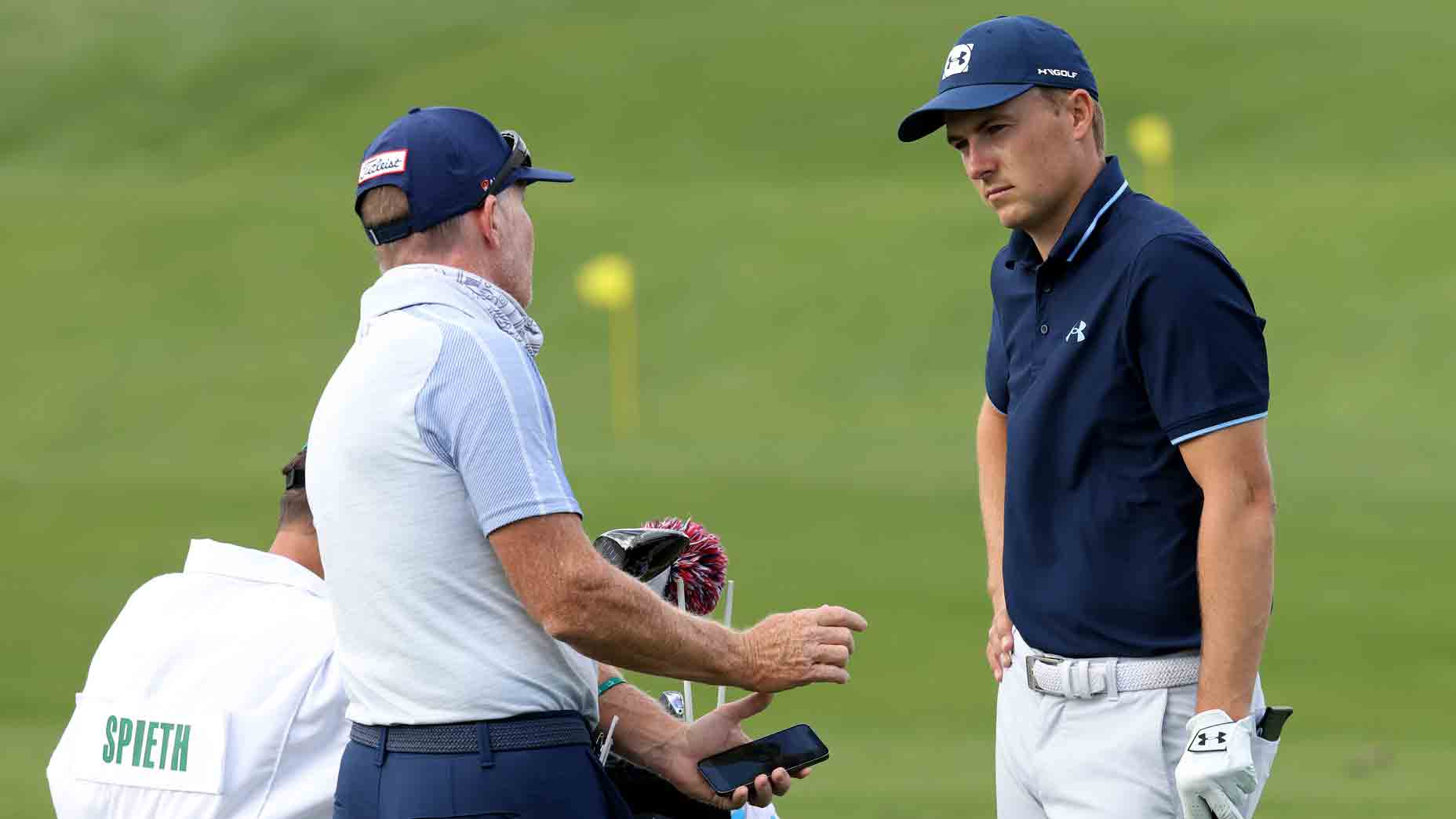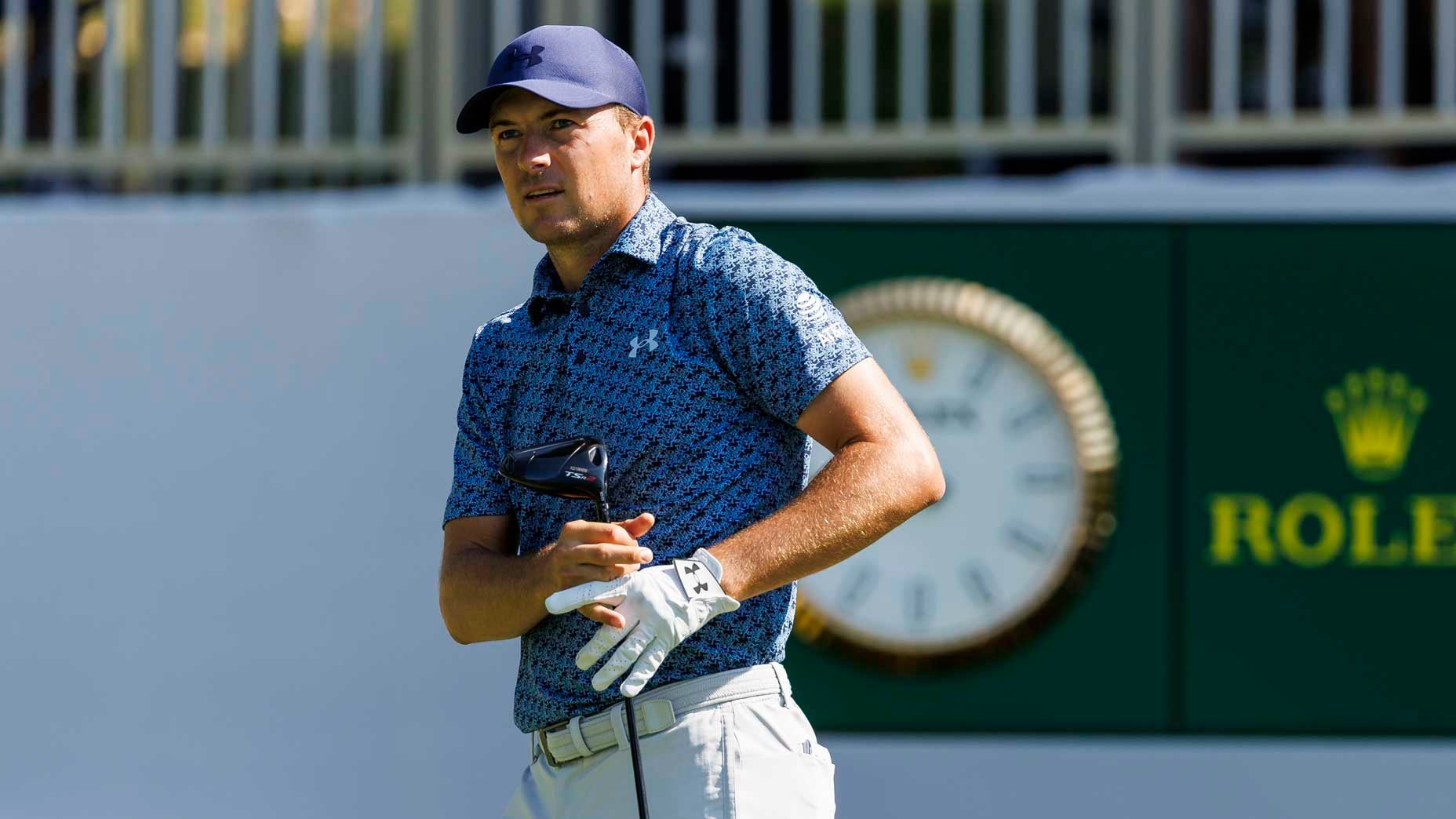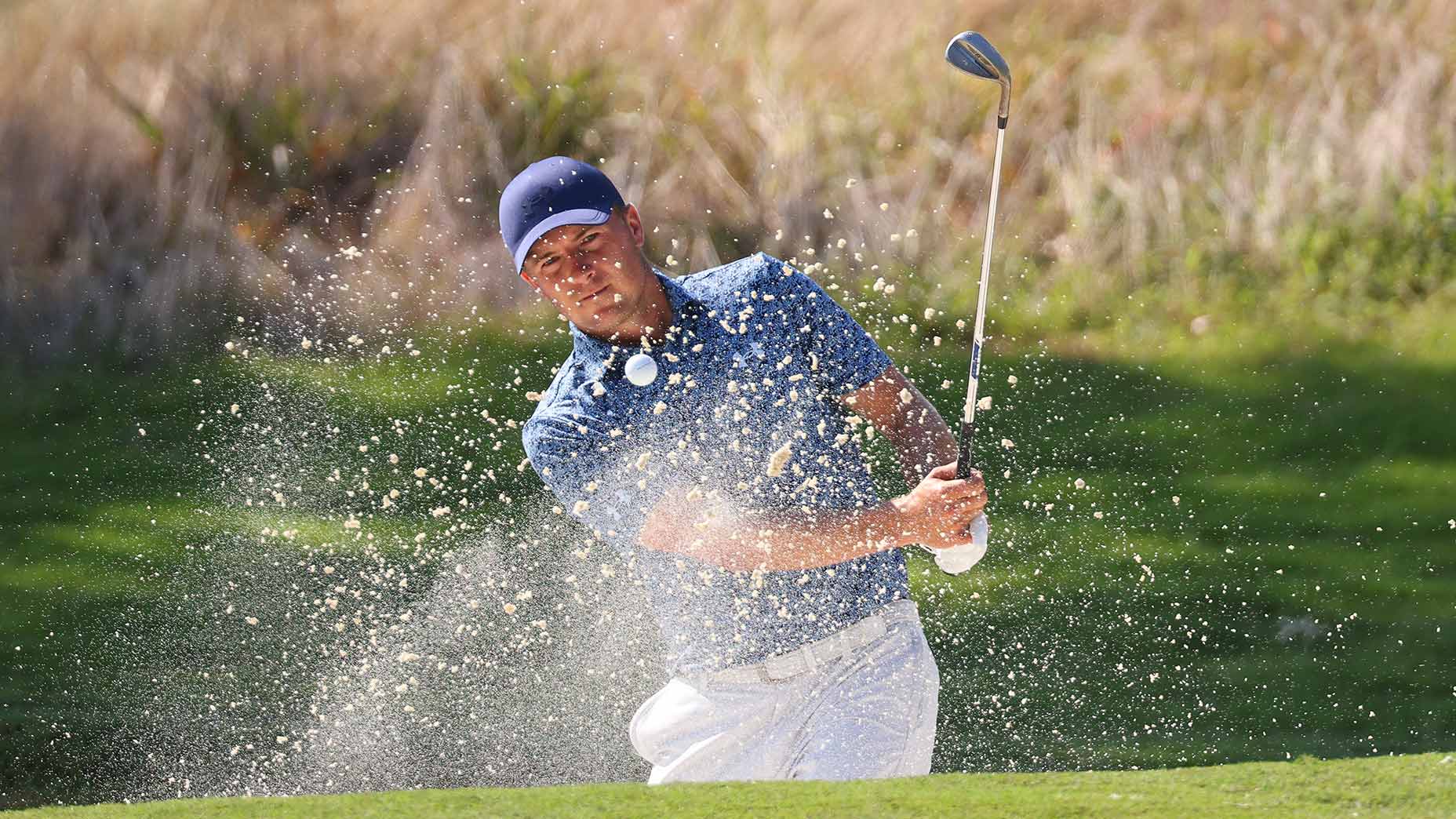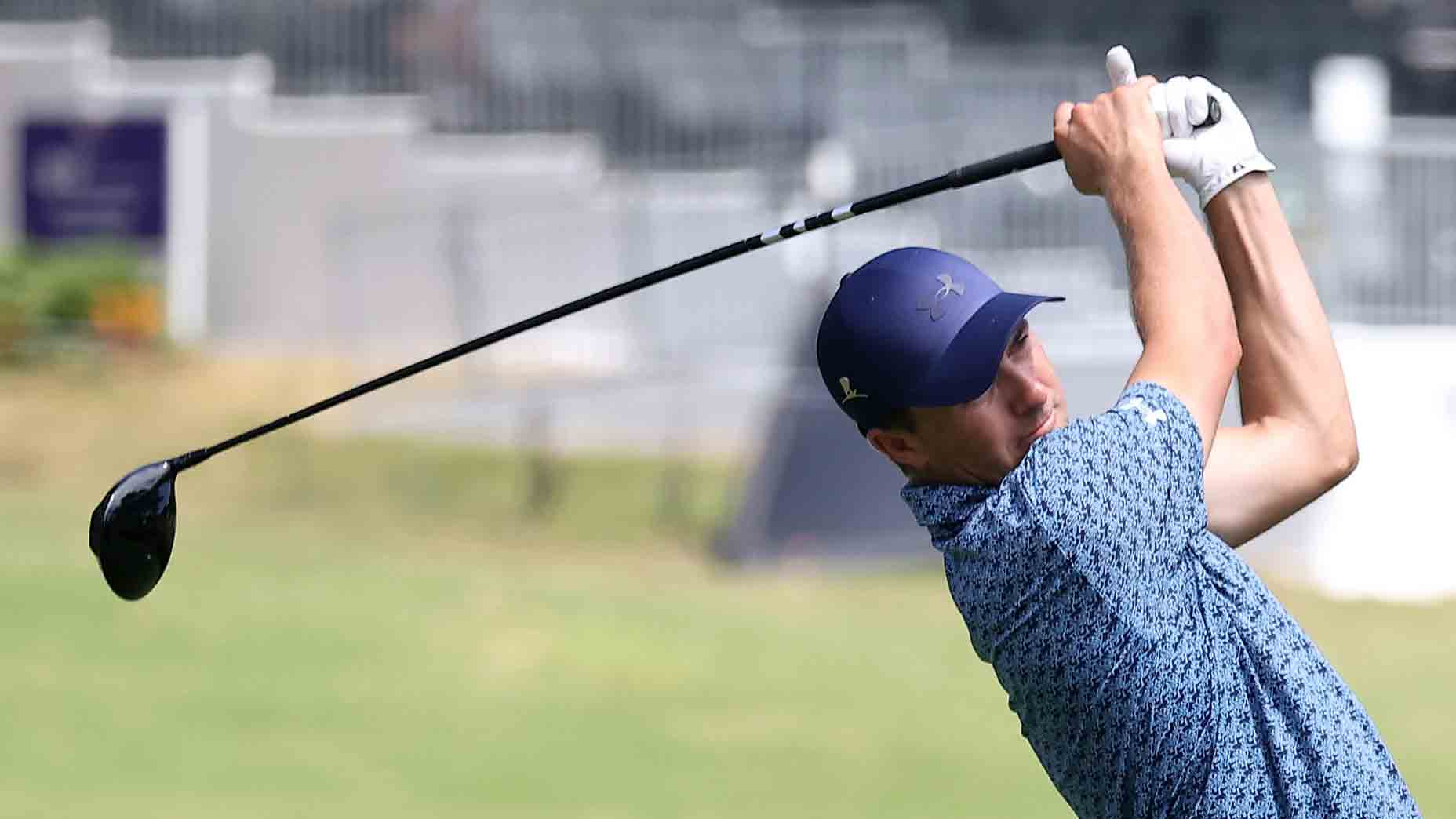To cure chunks and blades, Jordan Spieth’s coach uses a ‘pencil grip’
- Share on Facebook
- Share on Twitter
- Share by Email

Cameron McCormick, left, and Jordan Spieth at the 2020 Masters.
Getty Images
Cameron McCormick starts somberly.
Chunks, he says.
Blades.
Overly high iron shots “that travel far shorter than they otherwise should.”
But the mood quickly improves. He says the ghastly trio shares both a symptom and a cure.
McCormick, a GOLF Top 100 Teacher and Jordan Spieth’s longtime instructor, was talking on a recently posted video to his Instagram account — which you can watch in full here — and the cause behind the problems, he said, is an “overly active” trail hand (your right hand if you’re right-handed) in the swing.
“That overly active right hand,” McCormick said on the video, “essentially causes the grip, this end of the grip [he motioned toward the bottom of the grip, near the shaft], and therefore the clubhead, to spin down toward the ground too early, causing that fat contact, causing that high dynamic loft and high launching irons.”
So what’s the fix?
On practice swings, McCormick uses what he calls “a pencil grip.”
Here, McCormick holds the end of the grip between his right thumb and right index finger while keeping his left hand in its normal position — so the hands are separated by a few inches — before making swings, bringing the club back past the golf ball with his left hand. He then grips the club normally.
“And you’ll see the effect this is having,” he said on the video. “It’s actually increasing the angle between your lead arm and the club shaft.
“Without skipping a beat, place your hands back on correctly, quiet the right hand’s involvement and then blend it into a full swing. It’s going to solve the fat contact, [and] it’s going to drop the launch angle of your golf ball, providing more ball speed and longer distance.”
Did the author try it? You bet. The result? The move is fluid. The feedback is also instant.
Let’s continue the chunk talk. Below is the text from an article published by GOLF.com in 2022 and written by Top 100 Teacher Kellie Stenzel, with the headline reading: “10 ways to stop chunking your iron shots”:
***
There are few more frustrating shots in golf than hitting the ground too soon before impact. Fat shots not only leave you feeling inadequate, with your divot traveling farther than your ball, but they also leave you with little time to “walk it off” before trying the same shot again!
Follow this plan to avoid turf-tearing misses:
1. Check your posture
One of the most common set-up mistakes I see from golfers who hit a lot of heavy shots is a too-crowded posture at set-up, with the golfer standing too close to the ball and the club. Stepping back to give yourself more room between your body and the club can be a simple adjustment that can result in immediate improvement.
2. Set your club properly
Club soles are designed to help the club glide across the ground. If you incorrectly twist the club as you set it down so the sole is not properly on the ground, the leading edge can easily get stuck and dig. Assuming that your grips are installed correctly, simply making sure the markings are centered on the grip when it is set behind the ball can keep the leading edge from catching and digging.
3. Minimize shaft lean
If your club leans too far forward at impact, the leading edge can dig. This happens most often with short-game shots, because shorter shots don’t generate as much speed to offset digging tendencies. If you’re prone to steep “digging” shots, at address be sure to have the grip end of the club pointing more toward the center line of your body.
4. Proper ball position
If your ball position is too far forward, it’s likely you’ll hit the ground before the ball. I say to my students, “You are hitting the ground where the ball should be.” For hybrid, fairway wood and iron shots, your ball position should not be anywhere near as far forward as your driver. If you are hitting the ground before the ball, try simply moving the ball position back to the location where your club is striking the ground.
5. Pivot into your divot
In your forward swing, you should have an athletic pivot, in which your trail heel comes off the ground. (Keeping your back foot flat will often result in a fat shot.) This shift and pivot will help you to take a divot after impact. Practice an underhand throwing motion to feel and produce the correct pivot that you should strive to add to your swing.
6. Circular backswing
While all swings are different and there are so many versions of good swings, the backswing and almost all correct golf motion is circular. When you make a correct backswing, where your lead underarm should stay closer to your chest, the rotation that happens as a result will promote a circular backswing, rather than one that is incorrectly straight back. When your backswing curves and becomes circular, this will prevent it from getting too steep and digging into the turf. The resulting shallower swing path will not only help your club glide across the ground, but it also will produce more power.
7. Swing to your point of flexibility (and not beyond!)
The length of a golfer’s backswing is generally determined by their flexibility. More flexible golfers tend to have longer backswings. Less flexible players have shorter backswings — and that’s OK! You do not want to swing beyond your point of flexibility. Overswinging can lead to injury; also, when you swing beyond your body’s comfort level, your swing plane tends to shift up and get steeper, causing digging before impact. To test how far your body will allow you to swing back, drop to your knees and swing your arms back as far as you can without letting your lower body collapse. This will show you your range of motion and how far you should swing back the club.
8. Stance width
At address, your stance should be roughly hip-width, and slightly wider for driver. When your stance gets too wide, you increase the number of potential locations where your club can strike the ground. Narrowing your stance will also help your swing be more rotational and less lateral, minimizing the chance of hitting the ground before the ball. If your stance is the right width for your swing, when you rotate your body through impact, your right knee should meet your left without a gap between.
9. Hybrids are your friends
Hybrids have a wider sole than irons and thus are more likely to glide across the ground. If you hit too many fat shots, consider exchanging your low-to-mid-irons for hybrids.
10. Find the right wedges
Lofted wedges have bounce on them, which basically means when the sole is resting on the ground, the trailing edge of the club is closer to the ground than the leading edge. There are some amazing wedges in which the bounce is so well designed that with good technique you almost can’t get the club to dig. That’s super-useful for players who hit many fat shots, because if you know the club won’t dig, there isn’t any reason to be afraid to really thump the club into the ground.
When you are practicing or playing and you hit a shot fat, reacting quickly and making the necessary adjustment is essential to not only improving your contact but also maintaining your confidence. Experiment with the tips above to see what works best for you. Your game will thank you for it, and so will your superintendent.
Latest In Instruction

Nick Piastowski
Golf.com Editor
Nick Piastowski is a Senior Editor at Golf.com and Golf Magazine. In his role, he is responsible for editing, writing and developing stories across the golf space. And when he’s not writing about ways to hit the golf ball farther and straighter, the Milwaukee native is probably playing the game, hitting the ball left, right and short, and drinking a cold beer to wash away his score. You can reach out to him about any of these topics — his stories, his game or his beers — at nick.piastowski@golf.com.









